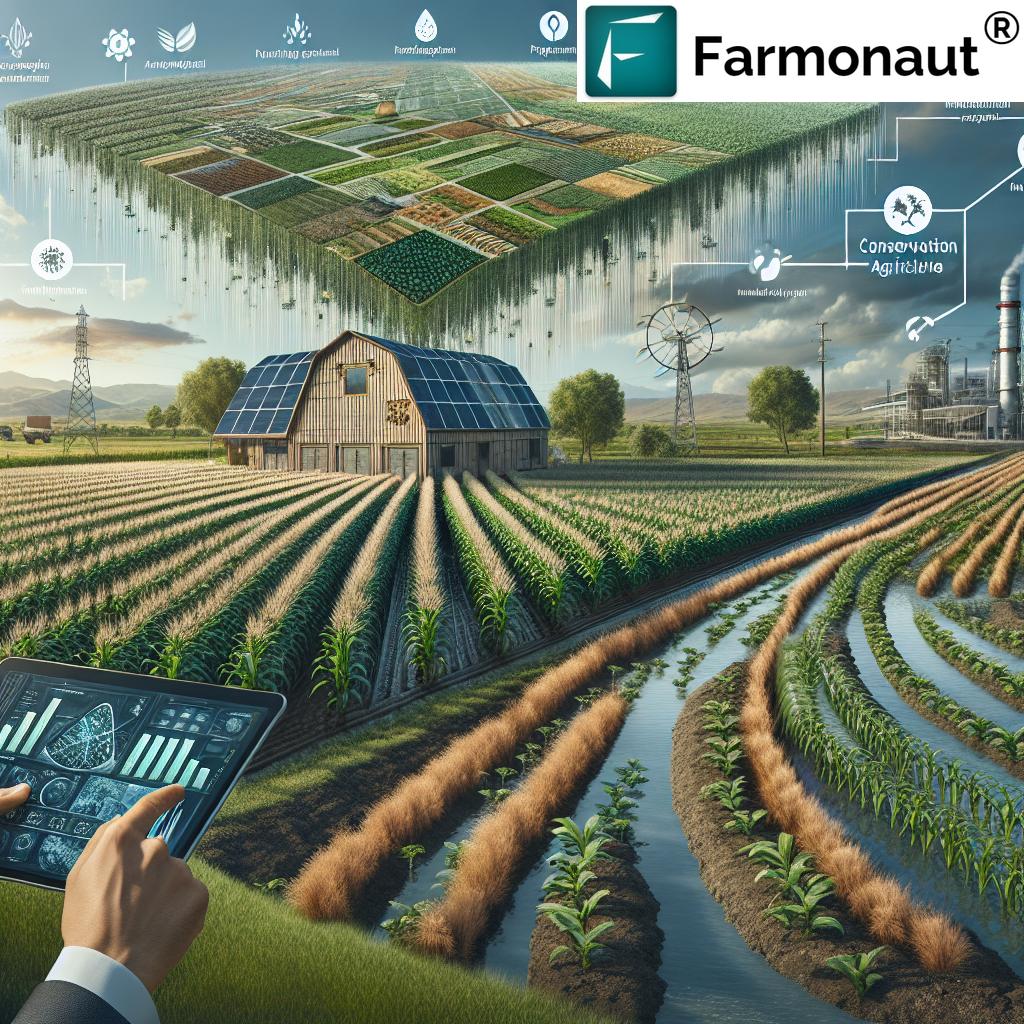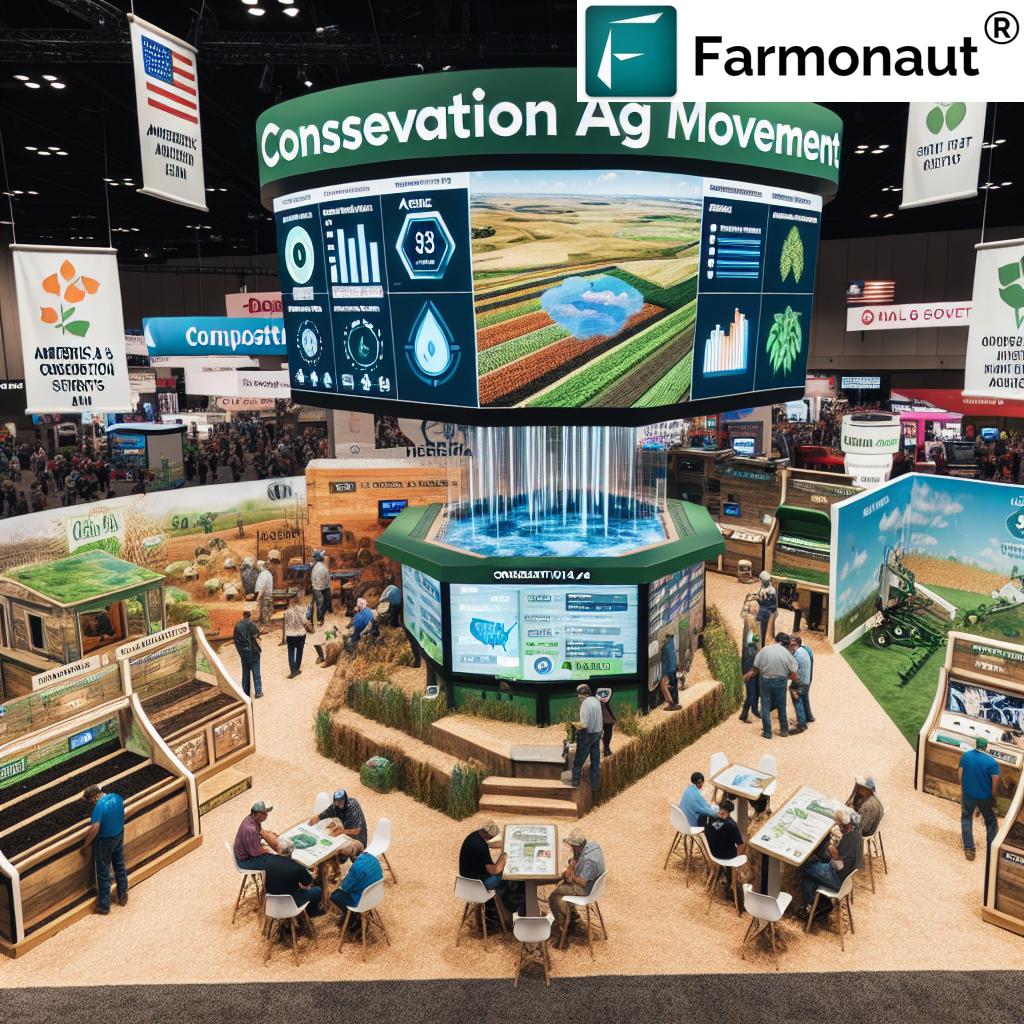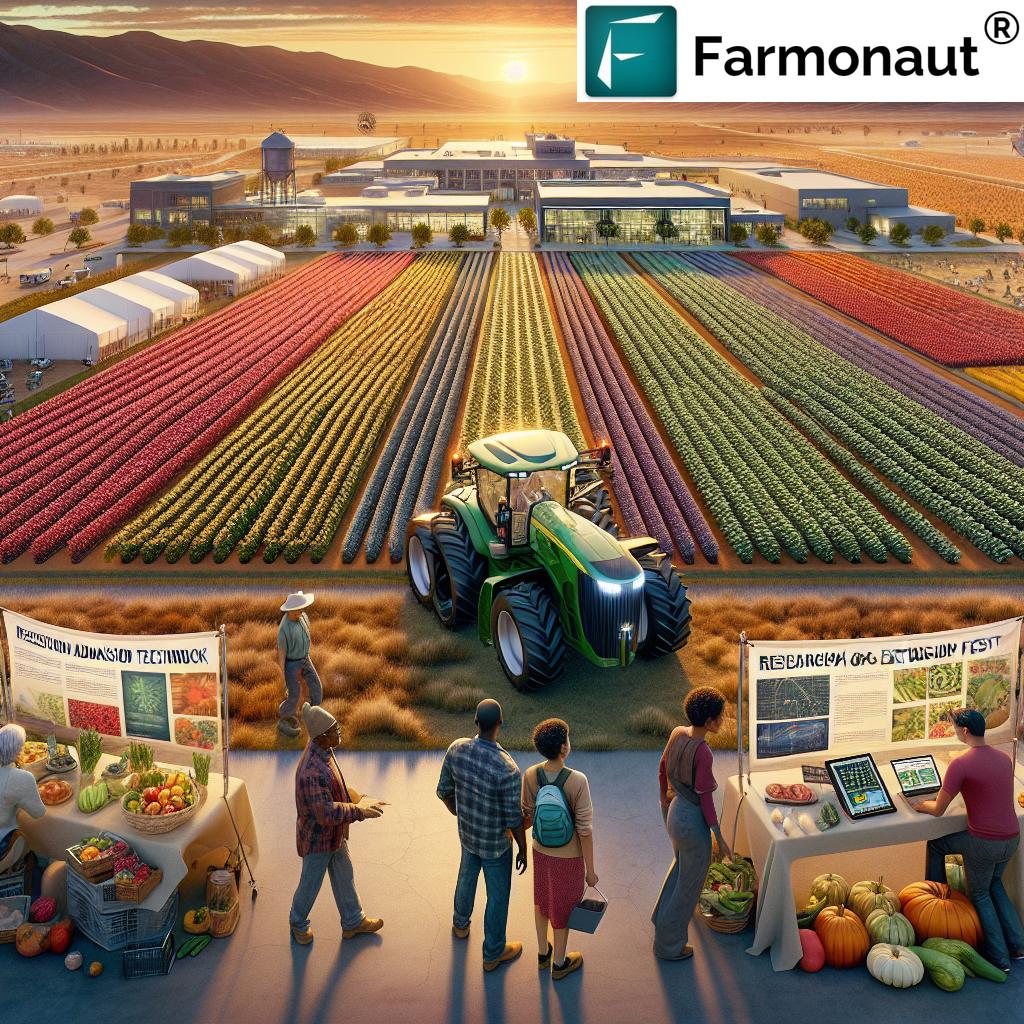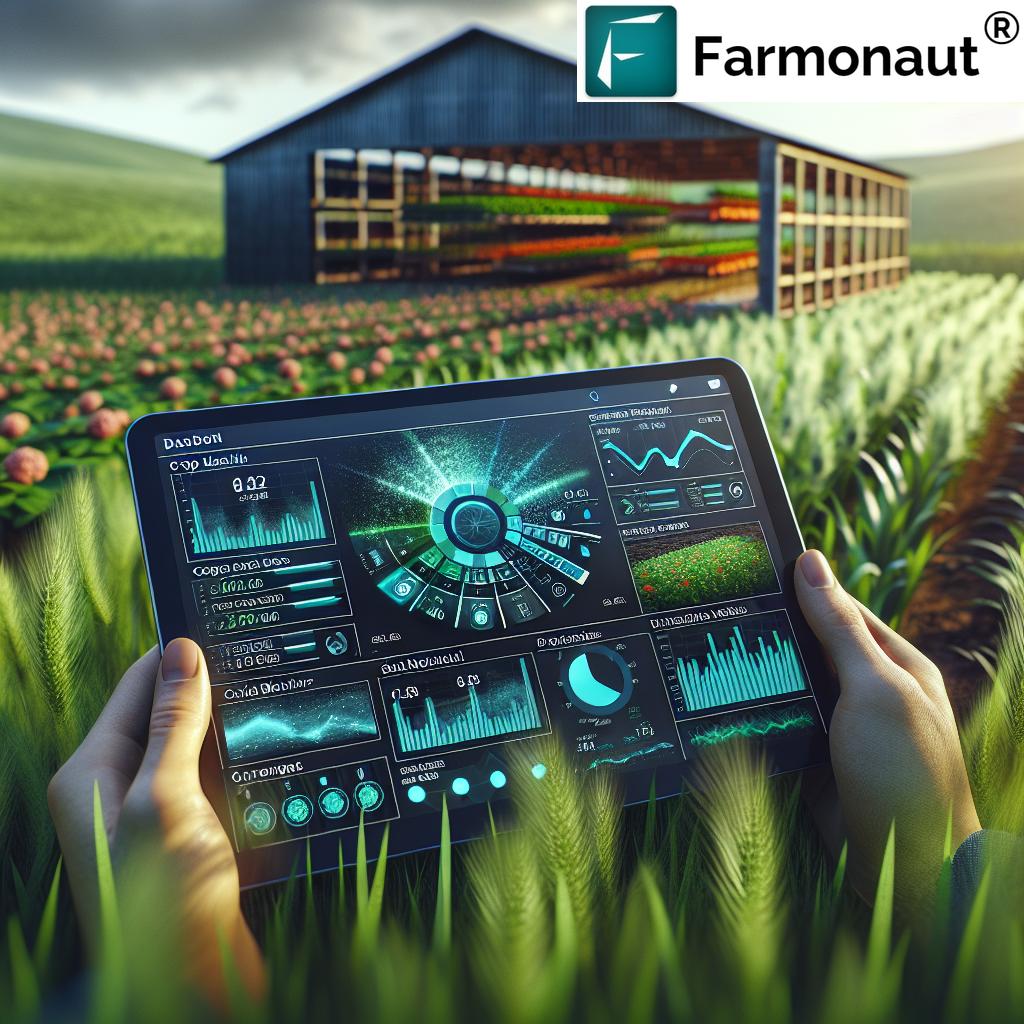America’s Conservation Ag Movement: Revolutionizing Sustainable Agriculture Practices for 2024 and Beyond

“Conservation agriculture practices can reduce soil erosion by up to 90% compared to conventional tillage methods.”
As we step into 2024 and beyond, the agriculture industry is witnessing a revolutionary shift towards sustainable practices. The America’s Conservation Ag Movement is at the forefront of this transformation, uniting industry leaders, farmers, ranchers, and consumers in a collective effort to promote environmental stewardship in farming. In this comprehensive guide, we’ll explore how this groundbreaking initiative is shaping the future of agriculture, with a focus on sustainable agriculture practices and conservation agriculture.
The Rise of America’s Conservation Ag Movement
The America’s Conservation Ag Movement is a collaborative effort that brings together various stakeholders in the agricultural sector. Its primary goal is to scale up the adoption of profitable conservation techniques among farmers and ranchers while educating consumers about modern, sustainable agricultural methods. This initiative is not just about preserving the environment; it’s about creating a sustainable future for agriculture that benefits everyone involved.
- Uniting industry leaders
- Promoting environmental stewardship
- Scaling up conservation techniques
- Educating consumers
As we delve deeper into this movement, we’ll explore how it’s revolutionizing farming practices and why it’s crucial for the future of agriculture.
Key Components of Sustainable Agriculture Practices
Sustainable agriculture practices are at the heart of the America’s Conservation Ag Movement. These practices aim to meet society’s food and textile needs in the present without compromising the ability of future generations to meet their own needs. Let’s explore some of the key components:
1. Soil Health Management
Soil health is fundamental to sustainable agriculture. The movement emphasizes practices that improve soil structure, increase organic matter content, and enhance soil biodiversity. These include:
- Minimal tillage or no-till farming
- Cover cropping
- Crop rotation
- Composting and organic amendments
By focusing on soil health, farmers can reduce erosion, improve water retention, and increase nutrient availability for crops.
2. Agricultural Water Conservation
Water is a precious resource in agriculture, and conservation is crucial. The movement promotes efficient irrigation systems and water management practices, such as:
- Drip irrigation
- Precision irrigation scheduling
- Rainwater harvesting
- Drought-resistant crop varieties
These practices not only conserve water but also reduce energy costs associated with pumping and distribution.
3. Precision Farming Technologies
Modern farming innovations play a significant role in sustainable agriculture. Precision farming technologies enable farmers to optimize resource use and minimize environmental impact. Some key technologies include:
- GPS-guided tractors and machinery
- Variable rate technology for fertilizer and pesticide application
- Remote sensing and satellite imagery for crop monitoring
- Soil and crop sensors for real-time data collection
These technologies help farmers make data-driven decisions, reducing waste and improving efficiency.
At Farmonaut, we’re proud to contribute to this technological revolution in agriculture. Our satellite-based farm management solutions provide real-time crop health monitoring, enabling farmers to make informed decisions about irrigation, fertilizer usage, and pest management. Learn more about our services by visiting our web app.
4. Crop Rotation Techniques
Crop rotation is a fundamental practice in sustainable agriculture. It involves alternating the types of crops grown in a specific field over seasons or years. Benefits of crop rotation include:
- Improved soil health
- Reduced pest and disease pressure
- Enhanced nutrient cycling
- Increased biodiversity
The America’s Conservation Ag Movement promotes diverse crop rotation systems tailored to different regions and farm types.
5. Organic Farming Methods
Organic farming is an integral part of sustainable agriculture. It emphasizes the use of natural processes and materials, avoiding synthetic fertilizers and pesticides. Key organic farming methods include:
- Biological pest control
- Green manures and compost
- Integrated crop-livestock systems
- Natural habitat preservation for beneficial insects and wildlife
The movement supports organic farming as a viable option for farmers looking to reduce their environmental impact and meet growing consumer demand for organic products.
“Implementing crop rotation techniques can increase crop yields by 10-25% while improving soil health and biodiversity.”
The Role of Technology in Conservation Agriculture
Technology plays a crucial role in advancing conservation agriculture. From satellite imagery to artificial intelligence, innovative tools are helping farmers implement sustainable practices more effectively. Let’s explore some key technological advancements:
1. Satellite-Based Crop Monitoring
Satellite technology has revolutionized how farmers monitor their crops. It provides valuable insights into crop health, soil moisture levels, and other critical metrics. This technology enables farmers to:
- Detect early signs of crop stress
- Optimize irrigation scheduling
- Monitor crop growth patterns
- Identify areas requiring attention
At Farmonaut, we leverage multispectral satellite images to provide farmers with real-time insights into their crop health. Our platform offers vegetation health indices like NDVI, helping farmers make data-driven decisions to optimize their yields and resource use. Explore our satellite-based solutions through our Android app or iOS app.
2. AI-Powered Advisory Systems
Artificial Intelligence (AI) is transforming agricultural decision-making. AI-powered advisory systems can analyze vast amounts of data to provide personalized recommendations for farmers. These systems can:
- Predict pest and disease outbreaks
- Recommend optimal planting and harvesting times
- Suggest appropriate crop varieties for specific conditions
- Optimize resource allocation based on historical and real-time data
Farmonaut’s Jeevn AI Advisory System is at the forefront of this technology, delivering real-time insights and expert crop management strategies to farmers. By analyzing satellite data and other inputs, Jeevn AI generates customized advice to improve farm productivity and efficiency.
3. Blockchain for Agricultural Traceability
Blockchain technology is enhancing transparency and traceability in agricultural supply chains. This technology allows for:
- Secure and transparent record-keeping of agricultural products
- Enhanced food safety through improved traceability
- Reduction of fraud in the supply chain
- Improved consumer trust through transparency
Farmonaut integrates blockchain technology to enable traceability solutions for various industries, particularly agriculture. Our blockchain-based system ensures that every stage of the product’s journey, from farm to consumer, is transparent and secure.
Collaborative Efforts in the Conservation Ag Movement
The success of the America’s Conservation Ag Movement relies heavily on collaboration between various stakeholders. This partnership approach ensures that sustainable agriculture practices are developed, implemented, and promoted effectively. Key collaborators include:
1. Government Agencies
Government agencies play a crucial role in supporting and regulating sustainable agriculture practices. Some key agencies involved include:
- United States Department of Agriculture (USDA)
- Environmental Protection Agency (EPA)
- Natural Resources Conservation Service (NRCS)
These agencies provide resources, funding, and policy support to promote conservation agriculture.
2. Non-Governmental Organizations (NGOs)
NGOs contribute significantly to the movement by:
- Conducting research on sustainable farming practices
- Providing education and training to farmers
- Advocating for policies that support sustainable agriculture
- Connecting farmers with resources and support networks
3. Agribusinesses
Agribusinesses are increasingly recognizing the importance of sustainable practices. They contribute to the movement by:
- Developing sustainable agricultural products and technologies
- Providing financial incentives for farmers adopting conservation practices
- Investing in research and development of sustainable farming methods
4. Farmers and Ranchers
As the primary implementers of sustainable practices, farmers and ranchers are at the heart of the movement. Their roles include:
- Adopting and refining conservation agriculture techniques
- Sharing knowledge and experiences with peers
- Participating in research and demonstration projects
- Advocating for supportive policies and programs
At Farmonaut, we support these collaborative efforts by providing cutting-edge technologies that enable farmers to implement sustainable practices more effectively. Our platform serves as a bridge between farmers, agribusinesses, and research institutions, facilitating knowledge sharing and data-driven decision-making. Learn more about our collaborative approach through our API and API Developer Docs.
Educational Initiatives and Consumer Awareness
Education and consumer awareness are crucial components of the America’s Conservation Ag Movement. These initiatives aim to:
- Inform consumers about sustainable agriculture practices
- Address concerns about the environmental impact of agriculture
- Promote the benefits of sustainably produced food
- Encourage consumer support for conservation agriculture
The movement utilizes various channels to achieve these goals:
1. Interactive Exhibits
Interactive exhibits showcase conservation agriculture practices, allowing consumers to experience and understand modern farming methods firsthand. These exhibits often feature:
- Demonstrations of crop rotation techniques
- Displays of organic farming methods
- Hands-on activities related to soil health and water conservation
- Virtual reality experiences of farm operations
2. Educational Programs
The movement supports various educational programs targeting different age groups and demographics. These programs include:
- School curriculum additions focusing on sustainable agriculture
- Workshops and webinars for farmers and agricultural professionals
- Community education events and farm tours
- Online courses and resources for self-paced learning
3. Media Campaigns
Media campaigns play a crucial role in raising awareness about conservation agriculture. These campaigns utilize:
- Social media platforms to share information and success stories
- Television and radio advertisements promoting sustainable farming
- Print media features in agricultural journals and mainstream publications
- Influencer partnerships to reach broader audiences
Farmonaut contributes to these educational initiatives by providing accessible, user-friendly tools that demonstrate the power of technology in sustainable agriculture. Our platform serves as an educational resource, helping farmers and consumers understand the impact of data-driven farming practices on sustainability.
Scaling Up Conservation Agriculture
One of the primary goals of the America’s Conservation Ag Movement is to scale up the adoption of profitable conservation techniques. This scaling process involves several key strategies:
1. Financial Incentives
Financial incentives play a crucial role in encouraging farmers to adopt sustainable practices. These incentives may include:
- Government subsidies for implementing conservation practices
- Tax credits for sustainable farming equipment and technologies
- Premium prices for sustainably produced crops
- Grants for on-farm conservation projects
2. Technical Assistance
Providing technical assistance helps farmers overcome barriers to adopting new practices. This assistance can include:
- On-farm consultations with conservation specialists
- Training programs on implementing sustainable practices
- Access to tools and technologies for precision agriculture
- Support in developing farm-specific conservation plans
3. Research and Innovation
Ongoing research and innovation are essential for improving and refining conservation agriculture practices. This includes:
- Field trials of new conservation techniques
- Development of climate-resilient crop varieties
- Research on the long-term impacts of sustainable practices
- Innovation in farm machinery and equipment for conservation agriculture
Farmonaut supports the scaling up of conservation agriculture through our innovative technologies. Our satellite-based monitoring and AI-driven advisory systems enable farmers to implement precision agriculture techniques at scale, regardless of farm size. By making these technologies accessible and affordable, we’re helping to democratize sustainable farming practices.
Addressing Environmental Concerns
The America’s Conservation Ag Movement directly addresses several critical environmental concerns related to agriculture:
1. Soil Erosion and Degradation
Conservation agriculture practices significantly reduce soil erosion and improve soil health. Techniques such as no-till farming and cover cropping help to:
- Maintain soil structure
- Increase organic matter content
- Improve water retention capacity
- Enhance soil biodiversity
2. Water Quality and Quantity
Sustainable agriculture practices have a positive impact on water resources by:
- Reducing runoff and water pollution from agricultural chemicals
- Improving water use efficiency through precision irrigation
- Enhancing water infiltration and storage in soil
- Protecting watersheds and aquatic ecosystems
3. Greenhouse Gas Emissions
The movement addresses agriculture’s contribution to climate change by promoting practices that:
- Increase carbon sequestration in soil
- Reduce emissions from farm operations
- Optimize fertilizer use to minimize nitrous oxide emissions
- Encourage the use of renewable energy on farms
Farmonaut’s technologies play a crucial role in addressing these environmental concerns. Our carbon footprinting feature helps agribusinesses monitor and reduce their environmental impact, while our precision agriculture tools optimize resource use, reducing waste and minimizing the environmental footprint of farming operations.
The Future of Sustainable Agriculture
As we look towards 2024 and beyond, the America’s Conservation Ag Movement is poised to drive significant changes in the agricultural landscape. Some key trends and developments to watch include:
1. Integration of AI and Machine Learning
Artificial Intelligence and Machine Learning will play an increasingly important role in sustainable agriculture, enabling:
- More accurate predictions of crop yields and pest outbreaks
- Automated farm management systems
- Advanced decision support tools for farmers
- Improved resource allocation based on big data analysis
2. Regenerative Agriculture
Regenerative agriculture practices, which go beyond sustainability to actively improve ecosystems, are gaining traction. These practices focus on:
- Rebuilding soil organic matter
- Restoring degraded soil biodiversity
- Improving the water cycle
- Enhancing ecosystem services
3. Urban and Vertical Farming
As urban populations grow, sustainable agriculture is expanding into cities through:
- Rooftop gardens and urban farms
- Vertical farming systems using hydroponic and aeroponic technologies
- Integration of agriculture into urban planning and development
- Community-supported agriculture programs in urban areas
4. Biotechnology and Gene Editing
Advances in biotechnology and gene editing techniques are opening new possibilities for sustainable agriculture, including:
- Development of drought-resistant crop varieties
- Improved nutrient use efficiency in plants
- Enhanced pest and disease resistance without heavy pesticide use
- Crops with improved nutritional profiles
At Farmonaut, we’re continually evolving our technologies to meet the future needs of sustainable agriculture. Our commitment to innovation ensures that farmers have access to cutting-edge tools that support conservation practices and drive the industry towards a more sustainable future.
Comparison of Conservation Agriculture Practices
| Practice | Description | Environmental Benefits | Economic Benefits | Adoption Rate |
|---|---|---|---|---|
| Crop Rotation | Alternating crops in a specific field over seasons or years | Improves soil health, reduces pest pressure, enhances biodiversity | Increases yield, reduces input costs | 60-70% of U.S. farmers |
| No-Till Farming | Planting crops without tilling the soil | Reduces soil erosion, improves soil structure, increases carbon sequestration | Reduces fuel and labor costs, improves long-term soil productivity | 35-40% of U.S. cropland |
| Cover Cropping | Planting non-cash crops to protect and improve soil | Prevents soil erosion, improves soil fertility, enhances water retention | Reduces fertilizer needs, improves cash crop yields | 5-10% of U.S. cropland |
| Precision Agriculture | Using technology to optimize farming practices | Reduces chemical use, minimizes environmental impact | Increases efficiency, reduces input costs | 50-60% of large U.S. farms |
| Organic Farming | Farming without synthetic inputs | Promotes biodiversity, reduces chemical pollution | Premium prices for products, lower input costs | 1% of U.S. farmland |
Conclusion
The America’s Conservation Ag Movement represents a pivotal shift in agricultural practices, emphasizing sustainability, environmental stewardship, and technological innovation. As we move into 2024 and beyond, this movement is set to revolutionize farming practices, addressing critical environmental concerns while ensuring food security for future generations.
By uniting farmers, industry leaders, government agencies, and consumers, the movement is creating a comprehensive approach to sustainable agriculture. From soil health management and water conservation to precision farming technologies and organic methods, every aspect of agriculture is being reimagined with sustainability at its core.
The integration of cutting-edge technologies, like those offered by Farmonaut, is playing a crucial role in this transformation. Satellite-based monitoring, AI-driven advisory systems, and blockchain traceability are empowering farmers to make data-driven decisions, optimize resource use, and minimize environmental impact.
As we look to the future, the continued success of the America’s Conservation Ag Movement will depend on ongoing collaboration, research, and innovation. By embracing these sustainable practices and technologies, we can create a more resilient, productive, and environmentally friendly agricultural sector that benefits farmers, consumers, and the planet alike.
The journey towards fully sustainable agriculture is ongoing, but with initiatives like the America’s Conservation Ag Movement leading the way, we are making significant strides towards a more sustainable and prosperous agricultural future.
FAQ Section
Q: What is the America’s Conservation Ag Movement?
A: The America’s Conservation Ag Movement is a collaborative initiative that brings together industry leaders, farmers, ranchers, and consumers to promote sustainable agriculture practices and environmental stewardship in farming.
Q: How does conservation agriculture benefit the environment?
A: Conservation agriculture benefits the environment by reducing soil erosion, improving soil health, conserving water, increasing biodiversity, and reducing greenhouse gas emissions from agricultural activities.
Q: What role does technology play in conservation agriculture?
A: Technology plays a crucial role in conservation agriculture by enabling precision farming, providing real-time crop monitoring through satellite imagery, offering AI-driven advisory systems, and facilitating traceability through blockchain technology.
Q: How can farmers get involved in the Conservation Ag Movement?
A: Farmers can get involved by adopting sustainable practices like no-till farming and crop rotation, participating in educational programs, utilizing precision agriculture technologies, and sharing their experiences with other farmers.
Q: What are some challenges in implementing conservation agriculture practices?
A: Challenges include initial costs of transitioning to new practices, learning curves for new technologies, potential short-term yield reductions, and the need for tailored approaches for different regions and farm types.
Q: How does conservation agriculture impact food security?
A: Conservation agriculture contributes to long-term food security by improving soil health, increasing farm resilience to climate change, and ensuring sustainable productivity of agricultural lands.
Q: What is the role of consumers in the Conservation Ag Movement?
A: Consumers play a crucial role by supporting sustainably produced foods, educating themselves about agricultural practices, and advocating for policies that promote sustainable agriculture.













